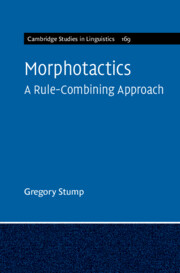Book contents
- Morphotactics
- Cambridge Studies in Linguistics
- Morphotactics
- Copyright page
- Dedication
- Contents
- Figures
- Tables
- Preface and Acknowledgments
- Abbreviations
- Symbols and Operators
- 1 Canonical Morphotactics
- 2 Rule Combinations
- 3 Dependent Rules and Carrier Rules
- 4 Rule Composition and Rule Ordering
- 5 Extending Canonical Morphotactic Criteria to Composite Rules
- 6 Rule Combinations Expressing Holistic Content
- 7 Rule Aggregation
- 8 Complex Morphotactic Interactions in Swahili
- 9 The Nonassociativity of Rule Composition in Murrinhpatha
- 10 Potentiation and Counterpotentiation
- 11 Rule Combinations and Morphological Simplicity
- 12 Rule‑combining Morphotactics and Morphological Theories
- 13 Conclusions
- References
- Index
7 - Rule Aggregation
Published online by Cambridge University Press: 24 November 2022
- Morphotactics
- Cambridge Studies in Linguistics
- Morphotactics
- Copyright page
- Dedication
- Contents
- Figures
- Tables
- Preface and Acknowledgments
- Abbreviations
- Symbols and Operators
- 1 Canonical Morphotactics
- 2 Rule Combinations
- 3 Dependent Rules and Carrier Rules
- 4 Rule Composition and Rule Ordering
- 5 Extending Canonical Morphotactic Criteria to Composite Rules
- 6 Rule Combinations Expressing Holistic Content
- 7 Rule Aggregation
- 8 Complex Morphotactic Interactions in Swahili
- 9 The Nonassociativity of Rule Composition in Murrinhpatha
- 10 Potentiation and Counterpotentiation
- 11 Rule Combinations and Morphological Simplicity
- 12 Rule‑combining Morphotactics and Morphological Theories
- 13 Conclusions
- References
- Index
Summary
Affix counterposition has two subcases: in the first (exemplified by the inflection of reflexive verbs in Lithuanian), an affix that is suffixed to the stem in some words is suffixed to a prefix in others; in the second, mirror-image case (exemplified by Noon adjective concord), an affix that is prefixed to the stem in some words is prefixed to a suffix in others. Rule aggregation models the phenomenon of affix counterposition as a deviation from the stem operand criterion involving a rule of affixation R whose operand is ordinarily a stem (when R isn’t aggregated) but is instead an affix (when R is aggregated to the rule introducing that affix). Rule aggregation brings affix counterposition into conformity with the affix directionality criterion. Nevertheless, there are real deviations from the latter criterion: some languages have true ambifixes that actually function as prefixes in some word forms but as suffixes in others. Gurma noun-class inflection exemplifies this possibility. Moreover, the morphotactics of Italian pronominal affixes involves a significant interaction between true ambifixation and rule aggregation.
Keywords
Information
- Type
- Chapter
- Information
- MorphotacticsA Rule-Combining Approach, pp. 182 - 223Publisher: Cambridge University PressPrint publication year: 2022
